I went many a year without knowing about nettle leaf tea. Perhaps you’re in the same boat I was in. Well, get ready, my friend! Make this organic nettle leaf tea recipe and enjoy its amazing health benefits and good taste without the sting!
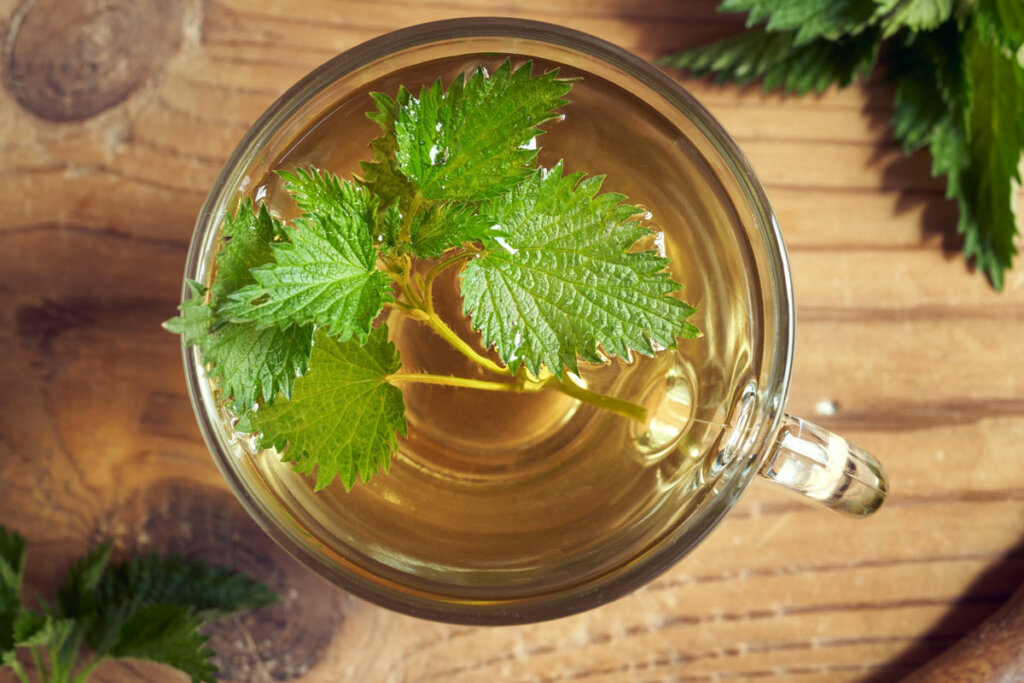
All of my life, I’ve viewed stinging nettles as, well, a stinging nettle. I mean, those suckers can pack a zinger. Building forts as kids, we always managed to get zapped by one of those pesky plants. They like to invade the yard and are a nuisance.
🍞 Struggling With Sourdough?
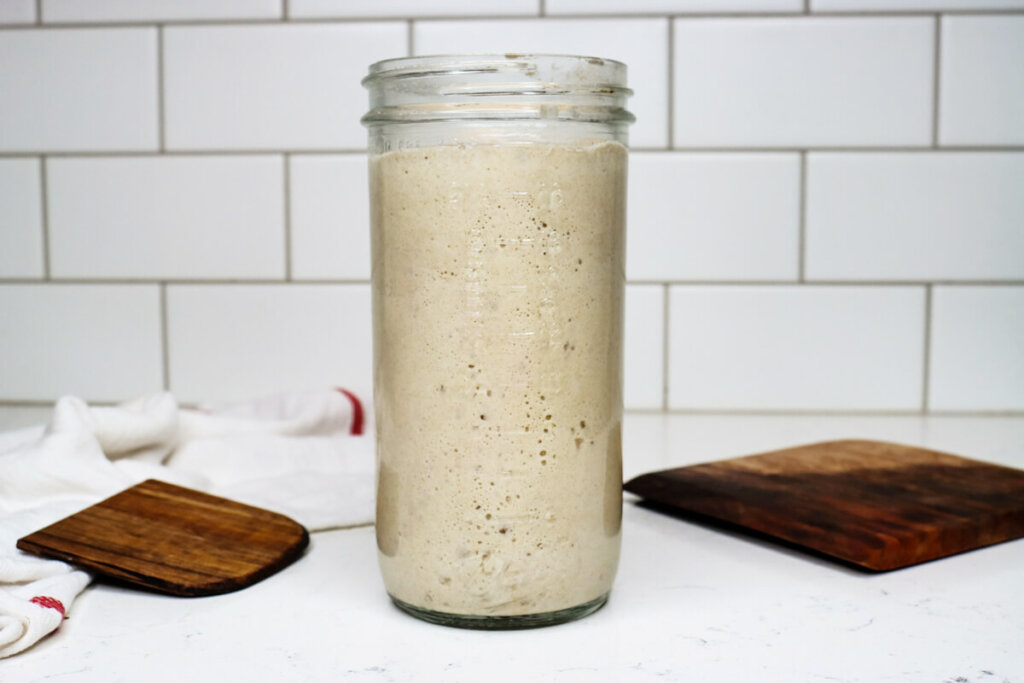
If your starter won’t take off, your loaves are dense and hard, or sourdough just flat-out overwhelms you…
👉 I’ll show you how to fix all of it.
Join my FREE live workshop and learn how to make a bubbly, active starter—the right way, from Day One.
🗓️ Jan 12 @ 1pm PT
Natural Remedies Made Simple
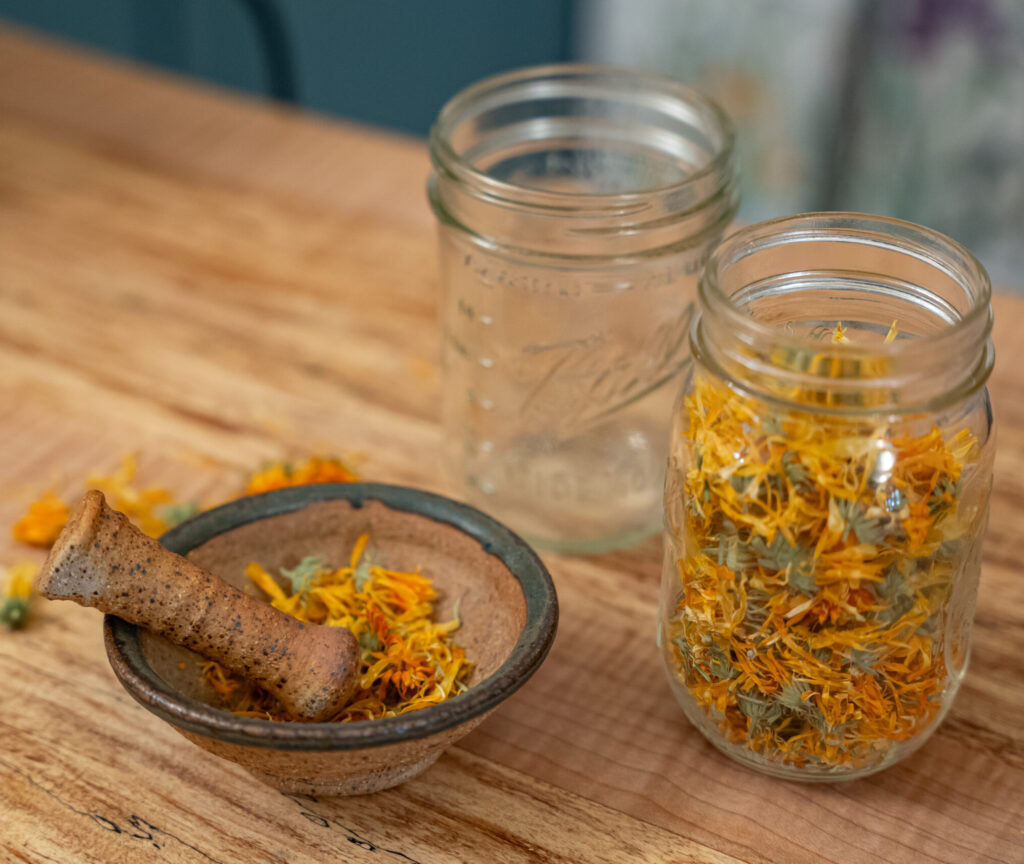
Start your home apothecary with confidence—even if you’re brand new. Learn how to choose the right herbs for your body using the simple principles of herbal energetics.
Discover how warming, cooling, drying, and moistening herbs affect your body—so you can stop guessing and start making remedies that actually work.
Or so I thought.
Little did I realize back then that you can drink nettle leaf tea and reap all its health benefits. Plus if you follow my post on how to harvest and preserve stinging nettle, you’ll save yourself from those nasty stings.
It’s important to note that I am not a certified medical practitioner. This post is not intended to diagnose or treat but is for informational purposes only. Please contact your healthcare professional before introducing new herbal remedies into your wellness routine.
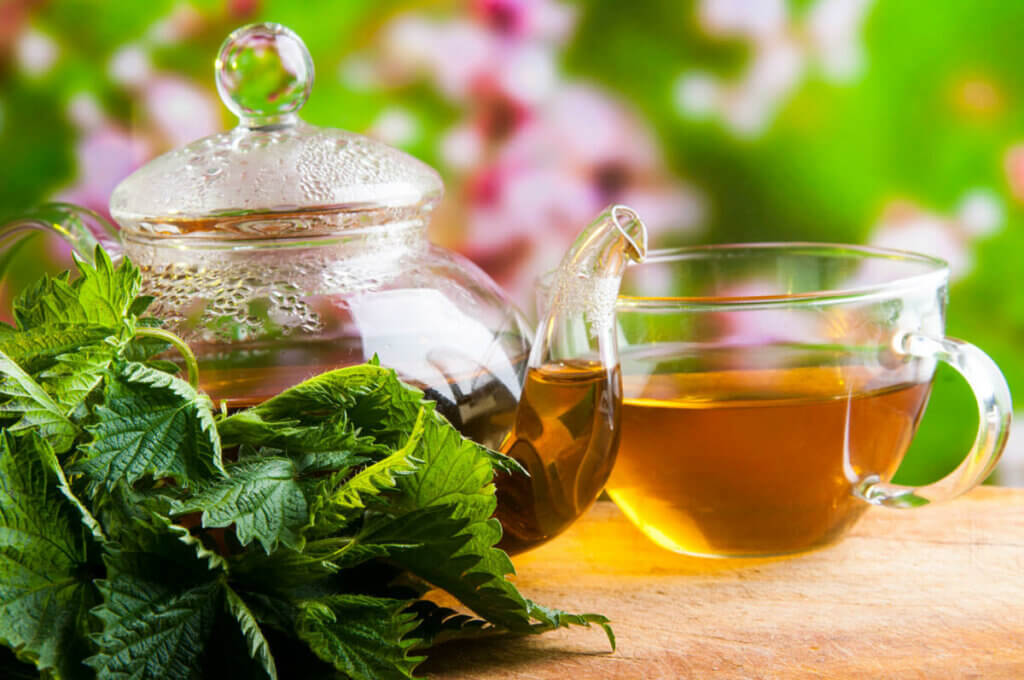
Table of Contents[Hide][Show]
Why I Love Nettle Leaf Tea
After years of designing my cottage garden to double as a medicinal herb garden, I became wise to the benefits of stinging nettles and purple dead nettles!
Instead of viewing them as dreadful weeds to avoid, I learned they can be used as medicinal weeds to prepare herbal remedies at home. I also learned how to harvest herbs for medicinal purposes and how to dry herbs for stronger medicinal properties.
I love drinking tea, and so naturally, I love using fresh and dried herbs to make herbal medicinal teas at home.
And once I learned about the many health benefits of stinging nettles, nettle tea became a favorite. I love drinking a cup in the morning and a cup in the evening.
I think it’s even more satisfying to drink nettle tea because I know that out in the woods, this plant causes all kinds of frightful injuries, but when boiled to make tea, it becomes a treasure trove of healthy vitamins and minerals.
Do yourself a favor and get ahead of the game. Try this recipe for nettle tea yourself.
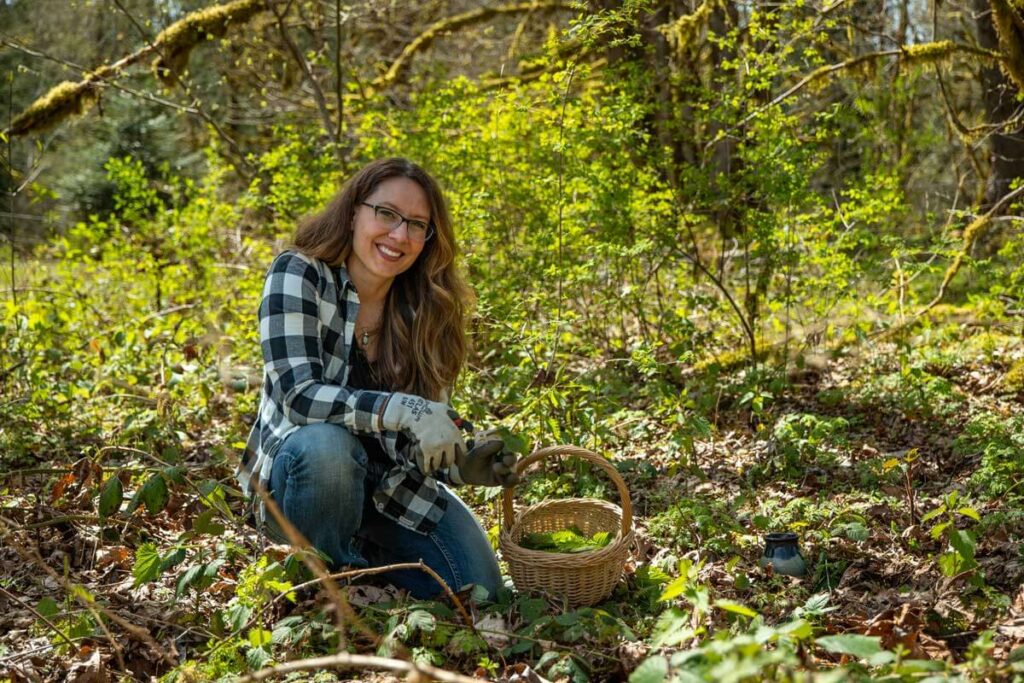
Health Benefits of Nettle Leaf Tea
The amazing stinging nettle plant (Urtica dioica), especially its leaf, packs many vitamins and minerals. Stinging nettles contain vitamins A, C, K and several B vitamins, antioxidants (hello boosting the immune system and fighting free radicals), minerals like calcium, iron, magnesium, phosphorus, potassium, amino acids, and polyphenols. (Source)
Nettle leaf is used to help aid a variety of common medical problems. (Source)
- Seasonal Allergies – The stinging nettle leaf contains antihistamine properties. Many people like to take it to reduce the effects of hay fever. (Source)
- Prostate Issues – Like a natural diuretic, drinking nettle tea when first becoming aware of an enlarged prostate gland or benign prostatic hyperplasia (BPH) can help increase urination. (Source)
- Urinary Tract Infections – Drinking stinging nettle can improve urinary tract infections. (Source)
- Inflammation – Nettle leaves contain anti-inflammatory properties. (Source)
- Lowering Blood Sugar – Stinging nettles may reduce blood sugar levels. (Source)
- Sore Muscles, Joint Pain, and Arthritis – Stinging nettles may reduce inflammation that causes pain. You can use it alongside nonsteroidal anti-inflammatories. It may even help with rheumatoid arthritis. (Source)
- Anemia – Eating iron-rich foods, like stinging nettle, combats anemia. (Source)
- Gout – Stinging nettle tea may help flush out the uric acid that causes gout. (Source)

Subscribe to Melissa K. Norris!
Get updates on the latest posts and more from Melissa K. Norris straight to your inbox.
We use your personal data for interest-based advertising, as outlined in our Privacy Notice.
What Are the Cons of Nettle Tea
Be careful when handling stinging nettle plants. The hairs on the outside contain histamine and other chemicals that cause itchy, burning sensations when it comes into contact with exposed skin. It must be boiled or steamed before use.
As with any herb, do ample research before ingesting it, especially if you have underlying health issues. Nettle may interact with medications like blood-thinning, diuretics, blood pressure, and anti-inflammatory drugs. Talk with your healthcare professional about the side effects of nettle tea.
Stinging nettle tea potentially lowers blood pressure since it’s a natural diuretic. Be sure to monitor your blood pressure if you are prone to experiencing low blood pressure or if you take medications for high blood pressure.
Likewise, one of the potential health benefits of nettle tea is its ability to lower blood sugar. That being said, pay attention to how nettle tea affects your blood sugar, especially if you have type two diabetes. Monitor your blood sugar and consult your healthcare professional. (Source)
Not enough research shows if you can drink nettle tea if you are pregnant or breastfeeding. Avoid it unless otherwise directed by your health care professional.
Lastly, some people experience digestive discomfort from stinging nettle tea. Use a little at a time to see how your body reacts.
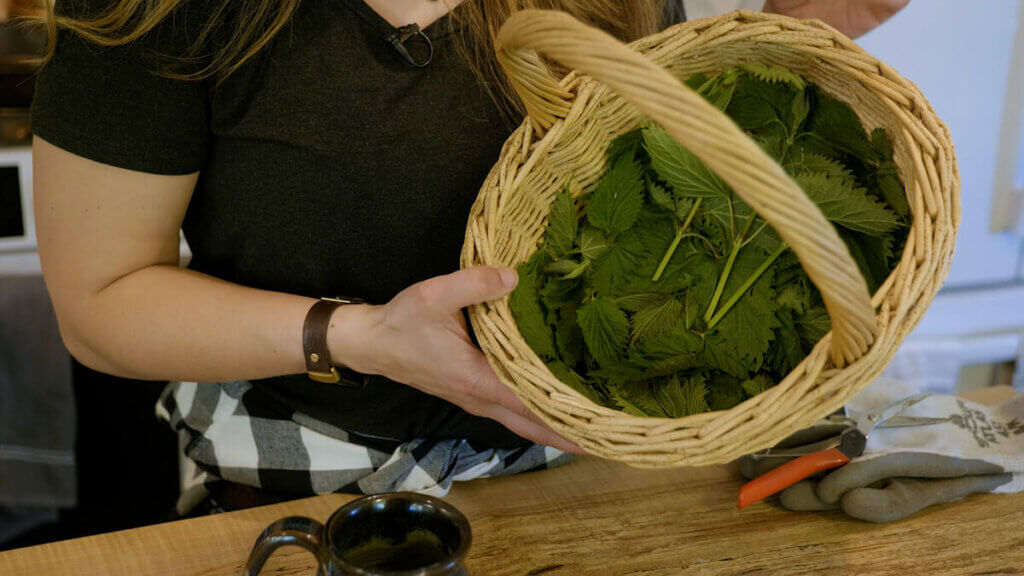
Is It OK to Drink Nettle Tea Every Day?
As with anything, listen to your body. Most people do just fine drinking a cup of nettle tea daily to support overall health. I actually like drinking a cup in the morning and a cup in the evening.
But, if you notice digestion issues or an upset stomach, back off on how much nettle tea you drink. Also, let your healthcare professional know you are drinking nettle tea if you have any existing health issues you are being treated for.
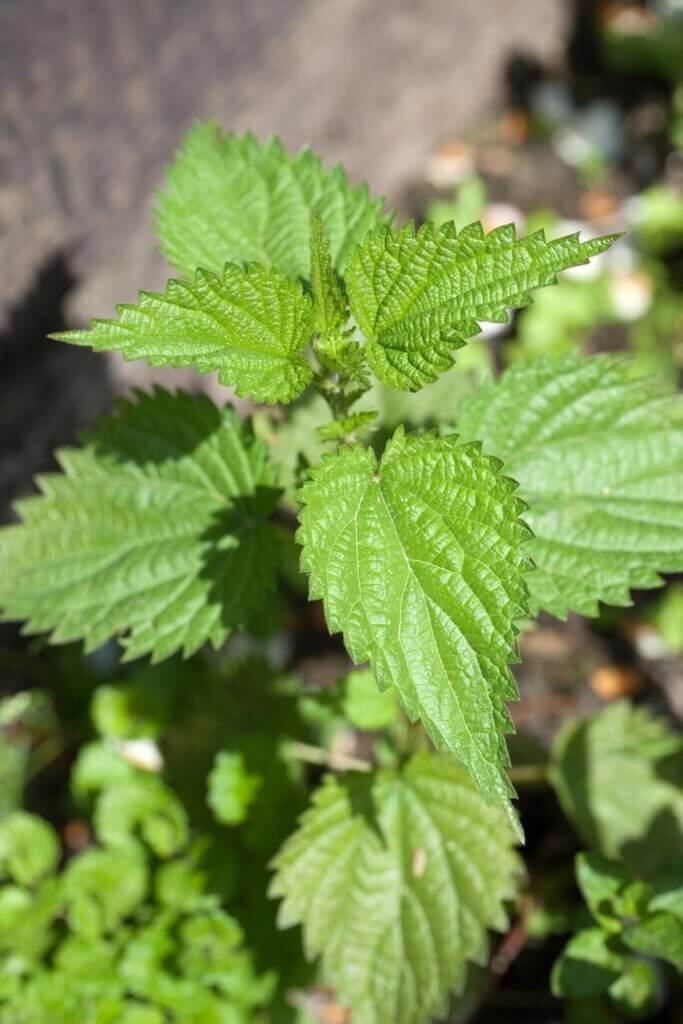
How to Make Nettle Leaf Tea
The first step to making nettle leaf tea is harvesting stinging nettles. Learn how to harvest nettle leaves in this blog post.
Supplies Needed
- Tea Kettle – You can use whatever you usually use to boil water.
- Mason Jar – You need a large, wide-mouth glass jar when using fresh nettle leaves. You could even use a second jar when straining the leaves out of the liquid.
- Coffee Filter or Cheesecloth – Use this to cover the Mason jar to allow the nettles to steep overnight. You can also use it to strain the tea.
- Mason Jar Lid – Save the leftover tea in the fridge in the Mason jar sealed with a lid.
- Tea Strainer – Use a tea strainer or a teapot with a tea strainer in it if you use loose, dried nettle leaves.
- Your Favorite Mug – Drinking tea in your favorite cup makes drinking medicinal tea even more enjoyable.
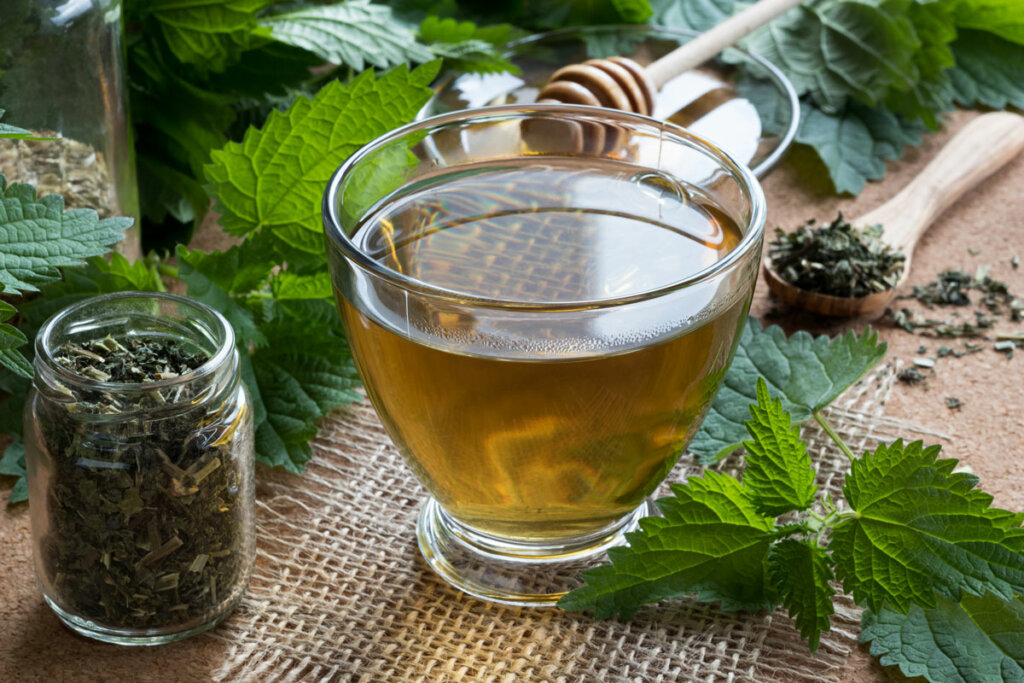
Ingredients Needed
- Nettle Leaves – You can choose to use fresh or freeze-dried (one cup) or dried (2 teaspoons) nettle leaves.
- Honey or Sweetener (optional) – As with many medicinal teas, they may not have the same naturally sweet flavor you’re used to in tea. Honey also has many great properties, which is why it’s my preferred method of sweetening tea. Add to your personal preference. You can choose another sweetener of choice or omit it altogether.
Not convinced you want to pick these prickly stingers yourself? No problem, you can order nettle leaves in bulk here. Or, grab it in premade nettle leaf tea bags to try it out first.
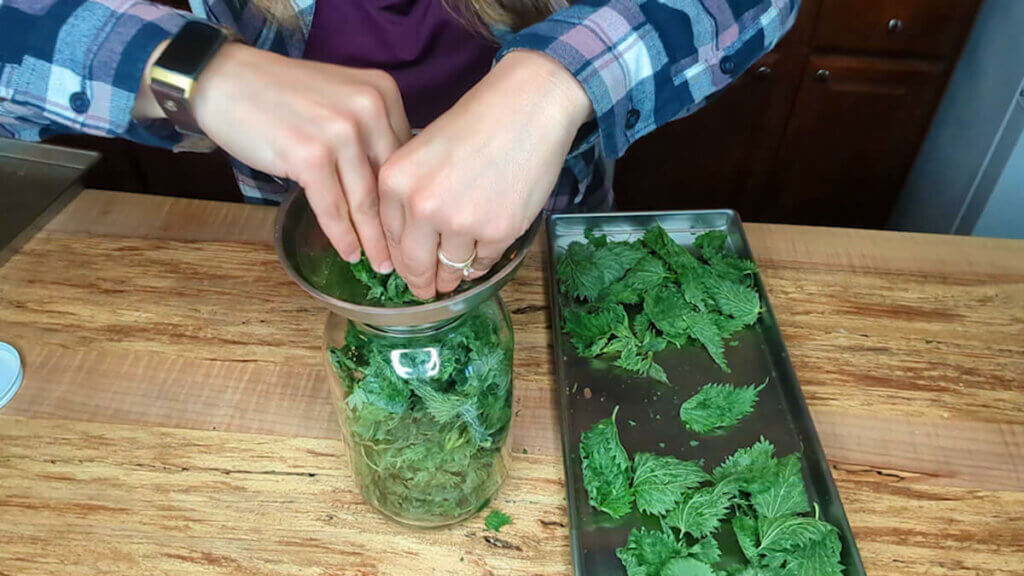
Making Nettle Leaf Tea Using Fresh or Freeze Dried Nettles
- Rinse your Mason jar in hot water to prep it for receiving boiling water. (This helps eliminate thermal shock and potentially cracking your jar.)
- Place approximately one cup of fresh or freeze-dried stinging nettle leaves in the jar. Add one cup of stinging nettles for every two cups of water. But, depending on your preference, you can add more water to make a weaker tea.
- Pour boiling water over the leaves to fill up the Mason jar.
- Cover with a coffee filter or cheesecloth.
- Once the tea has cooled slightly, you can add honey to taste and stir to dissolve.
- Let the leaves steep in the water for about 10 hours or overnight.
- Strain and drink a cup at a time over the next two days. It’s really good over ice!
- Place a lid on the Mason jar and store your nettle tea in the fridge. Consume within three days for the most medicinal benefits.
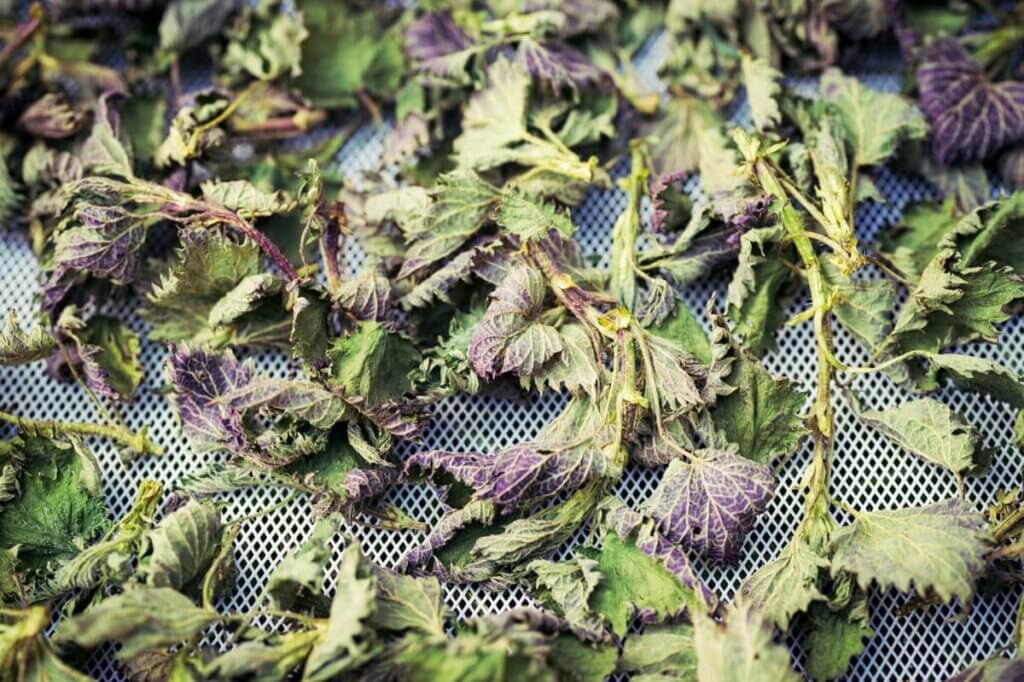
Making Nettle Leaf Tea Using Dried Nettles
- Place about two teaspoons of dried nettle leaves in a tea strainer and place the strainer in a mug.
- Pour in boiling water, cover, and let it steep for 10 to 15 minutes.
- Add honey or sweetener of choice, stir to dissolve.
- Strain out and discard leaves.
- Sip and enjoy!
Did you make this recipe? If so, please leave a star rating in the recipe card below (this helps me out!). Then, snap a photo of your nettle leaf tea and tag me on social media @melissaknorris so I can see!

Practical Home Herbalism
Now that you know how easy it is to incorporate nettle leaf tea into your natural healthcare routine, you will likely start using more herbal remedies at home.
Join my mini herb series here (it’s FREE) and start learning about each herb and how to incorporate them into your daily life.
Or, if you’re ready to jump in and start learning which herbs to grab when you have a headache, cough, congestion, upset stomach, or flu, grab my Practical Home Herbalism Course.
In my course, I’ll teach you how to listen to your body, learn what remedies work best for you, and even make them yourself to build up your herbal medicine cabinet that you can feel confident using for yourself and your family.
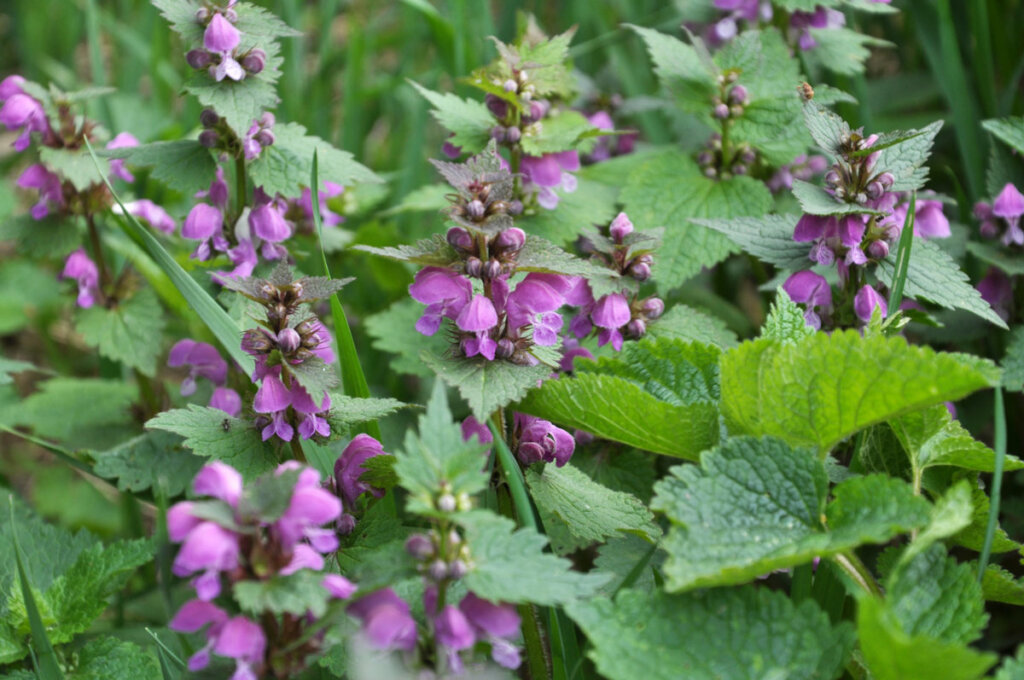
Other Articles You May Enjoy
- Stinging Nettle Benefits (Foraging & Preserving)
- Purple Dead Nettle (Foraging, Medicinal, and Cooking Guide)
- How to Use Herbs and Natural Remedies at Home
- How to Harvest Herbs for Medicinal Purposes
- Medicinal Herb Garden (Planning & Growing)
- Best Methods for Drying Herbs for Stronger Medicinal Properties
- How to Make Herbal Tea
- How to Design a Cottage Garden
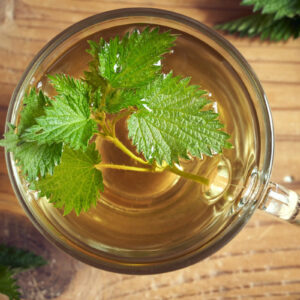
Nettle Leaf Tea Recipe (Dried or Fresh Herbs)
Equipment
- Tea Pot
- Tea Steeper
- Spoon
Ingredients
- 2 teaspoons nettle leaf dried (or 1 cup fresh or freeze-dried)
- 2 cups water
- 1 teaspoon honey or other sweetener, to taste (optional)
Instructions
Fresh or Freeze-Dried Nettles
- Rinse your Mason jar in hot water to prep it for receiving boiling water. (This helps eliminate thermal shock and potentially cracking your jar.)
- Place approximately one cup of fresh or freeze-dried stinging nettle leaves in the jar. Add one cup of stinging nettles for every two cups of water. But, depending on your preference, you can add more water to make a weaker tea.
- Pour boiling water over the leaves to fill up the Mason jar.
- Cover with a coffee filter or cheesecloth.
- Once the tea has cooled slightly, you can add honey to taste and stir to dissolve.
- Let the leaves steep in the water for about 10 hours or overnight.
- Strain and drink a cup at a time over the next two days. It's really good over ice!
- Place a lid on the Mason jar and store your nettle tea in the fridge. Consume within three days for the most medicinal benefits.
Dried Nettles
- Place about two teaspoons of dried nettle leaves in a tea strainer and place the strainer in a mug.
- Pour in boiling water, cover, and let it steep for 10 to 15 minutes.
- Add honey or sweetener of choice, stir to dissolve.
- Strain out and discard leaves.
- Sip and enjoy!

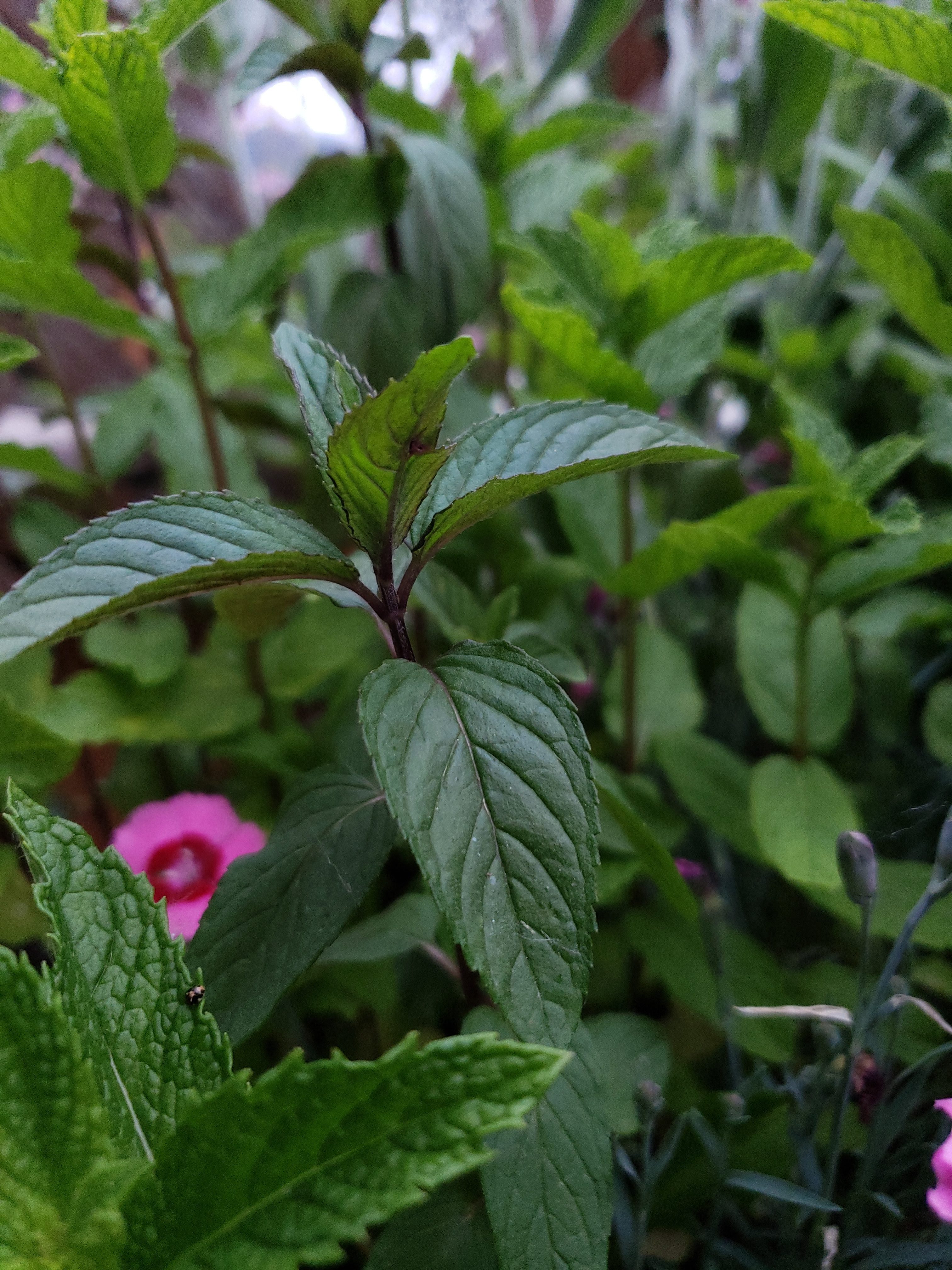
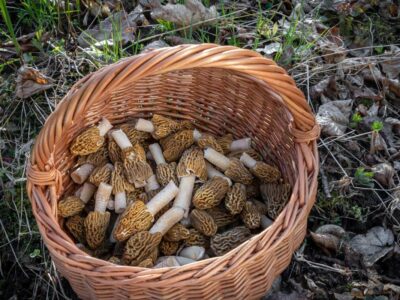






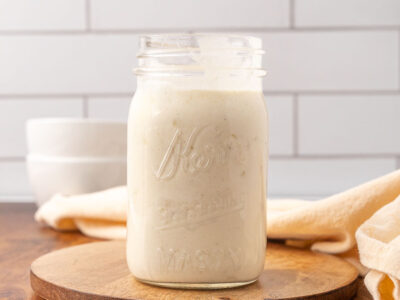
Hello, how do you avoid echonococossis or liver fluke ?
I only collect things whose are above my waist or more, like blackberries or plums. Is hot water enough ?
Thanks.
Mélissa (from France)
Melissa I so appreciate you taking the time to send me all this information on stinging nettles tea and all the other information you sent also. Thank you so much, Your a very good friend!!!***
Okay, I had absolutely no idea that ANYTHING GOOD could come from stinging nettle. I’ve spent my entire life “trying” to avoid this stuff.
I love tea so I’m definitely going to have to try this but I’ll admit, it seems very strange to me that I’ll actually be looking for nettle now. That’s going to take some getting use to.
[…] nettle pesto. Also, haven’t you heard? Nettle is the new kale. Nettle chips recipe here. And here are easy instructions for how to make tea using fresh and dried nettle leaf (because it’s better than how I tried […]
Just wondering if the nettles you described are what is called ‘bull nettles’ in Texas. After moving here from Missouri, I was pulling weeds and got ‘stuck’ then it went numb for about 4 hours. (Yes. I now use gloves while pulling weeds!). Thanks for your cool website.
Helen,
Hmmm, I’m not sure. When we get stung it turns into a raised wed welt and feels tingly/stingy for quite awhile depending upon the strength of the stinging nettle. Thanks for visiting and yes, those gloves can be life savers.
[…] a salad or cooked, the blossoms can be made into dandelion jelly, and you can also roast the roots. Stinging nettles can be made into tea, used in soups, or sauteed with some butter. We love morel mushrooms and go foraging for morels any […]
[…] I came across using nettle leaf tea and red raspberry leaf tea. You can check out my experience with the nettle tea and how to harvest and make nettle leaf tea here. […]
Can you make the nettle tea with raspberry leaves also…would you use the same ratio? Thanks!
Hi, Beccah,
You can make nettle tea with raspberry leaves, but I usually make mine separate. Just do the same ratio. It took a couple of weeks before I noticed a difference, but it’s definitely made a huge difference.
[…] How to Make Nettle Leaf Tea: https://melissaknorris.com/2014/03/19/wild-edible-plants-make-nettle-leaf-tea/ […]
This is SO interesting! I would love to start foraging and taking advantage of all the plants that God gave us and intended for us to use! I currently have an IUD b/c of heavy periods but it’s due to come out in August and I know I don’t want another. It’s done great for me but my perspective on health has changed since then. I’m also seeing an alternative medicine doctor who thinks there are other ways we can work to keep me from having that problem but naturally. Sounds like nettle leaf is one way!!
Leslie,
Nettle leaf is awesome, and works really well when paired with Red Clover Leaf tea and Red Raspberry leaf. I rotate each one over three days. I’ll have some other posts about each of them and harvesting as they come in season here. I’m usually skeptical about things, but this one proved to be so helpful to me.